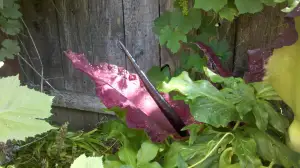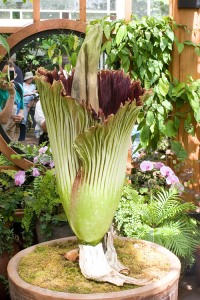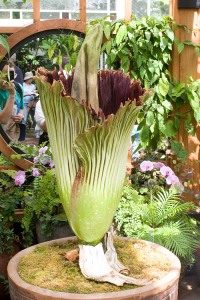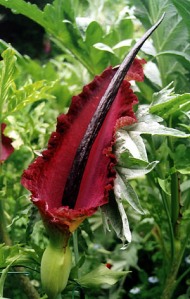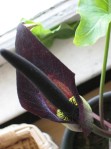
Helicodiceros muscivorus
Dead horse Arum or Dead Horse Lily
Family: Araecea
(Synonyms are Helicodiceros crintius and Dracunculus crintitus–I prefer this one of course!)
This Mediterranean island native is, next to the Corpse Plant, the category killer for rotten botanicals. Like it’s odoriferous cousins the Voodoo Lily and the Vampire Lily, The Dead Horse Arum lures flies and carrion beetles to its pollen coated stamen with the alluring smells of rotting meat, or rotting flesh of horses.(And like its cousins Voodoo and Vampire, it is also not really a lily.)
This beauty sports a wide inflorescence, with a somewhat phallic spadix (well, have you met a spadix that isn’t phallic?) which is made up of tiny male and female flowers. What is referred to as the flower is actually a modified leaf (spathe) plus spadix made up of tiny flowers. The spathe is moddled, usually a rich shade of red but can have some green and even white. The spadix is typically black or deep maroon.
The Dead Horse Arum is also one of a rare group of thermogenic plants. It can raise its own temperature, a handy trick to convince those flies that it really is hot, dead, flesh. How rotten is that? The Corpse Plant does this as well.
Incidentally, other plants that are thermogenic include the Elephant Ear philodendron and certain water lilies. Who knew?
Similar to other arums or aroids the Dead Horse Arum goes dormant. It is grown from a corm and likes a nice hummus rich soil, does great in containers, and can even withstand a bit of a temperature drop, as long as its buried snugly in a said hummus-y soil. I expect this would do well in most climates if kept in a container and properly mulched/brought into a hot house for the winter. That being said, I’m spoiled in my Mediterranean San Francisco climate and wonder if any of you inlanders, Southerners, or Northern Europeans have any experience growing this savory rotanical? Let us know !

